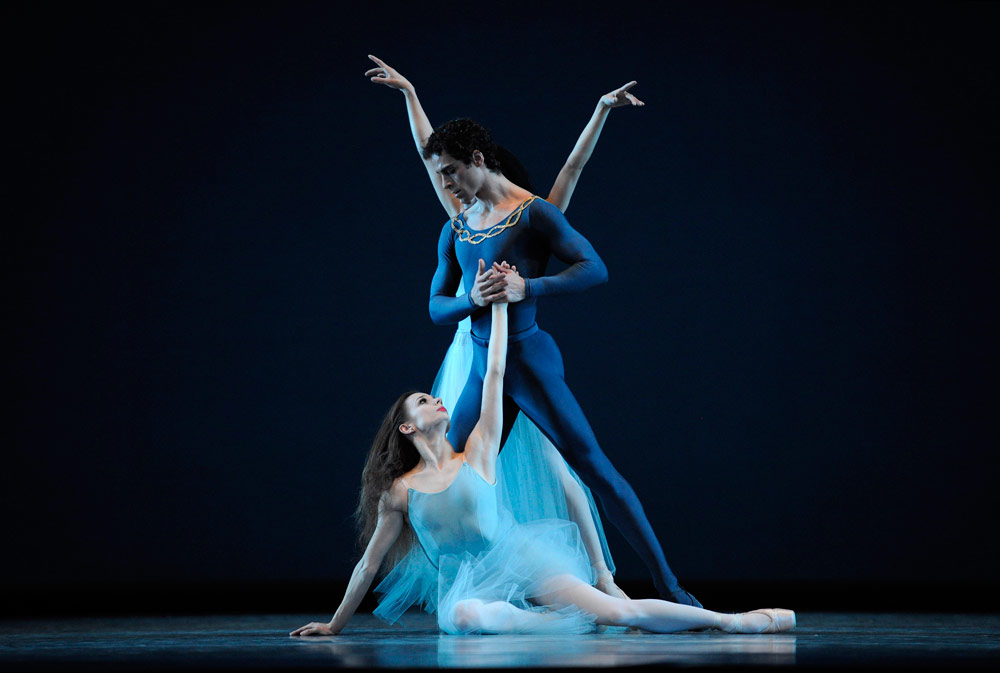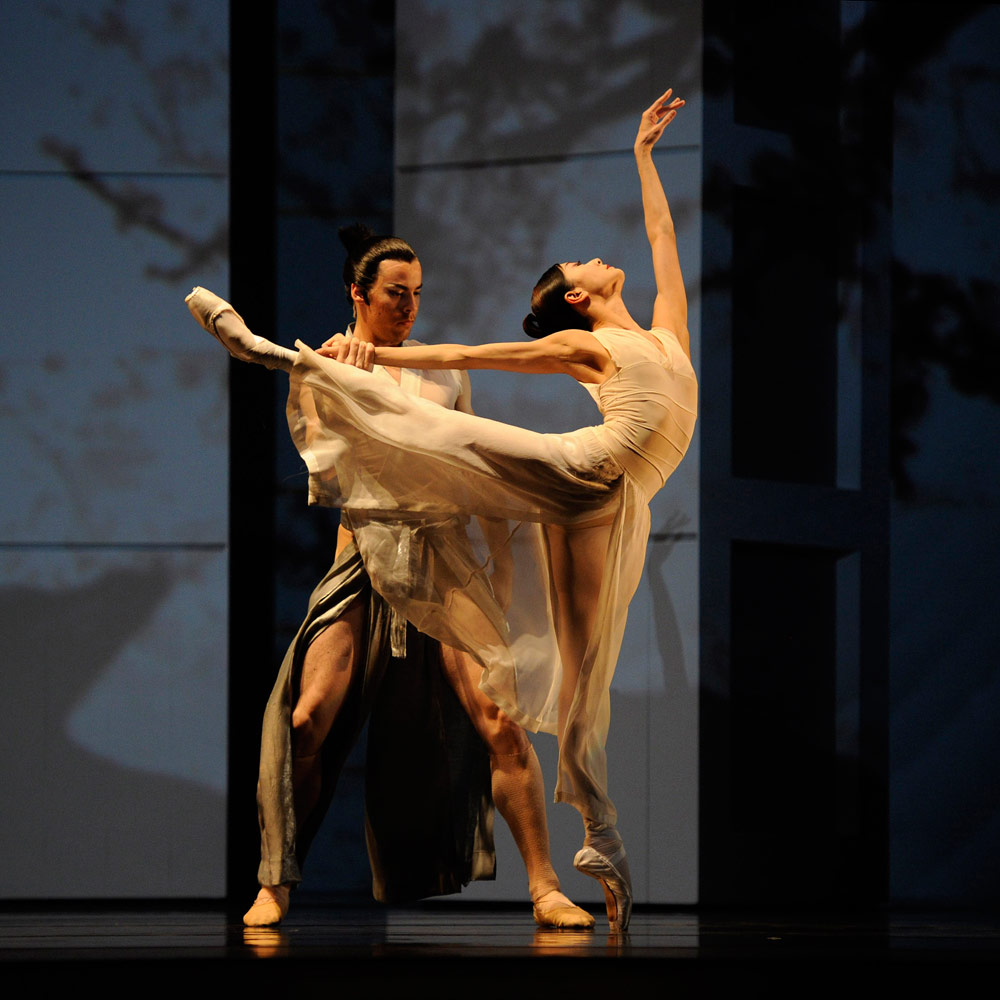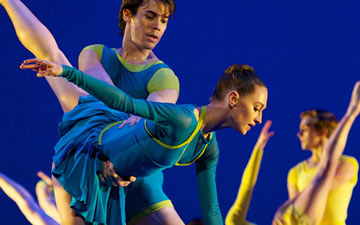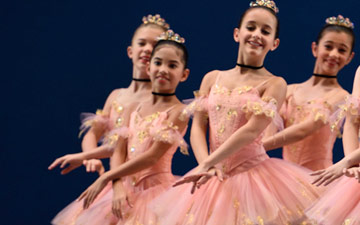
© Erik Tomasson. (Click image for larger version)
San Francisco Ballet
Program 1: Serenade, RAkU, Lambarena
San Francisco, War Memorial Opera House
27 January 2015
www.sfballet.org
America’s oldest ballet company, San Francisco Ballet, opened its eighty-second season with a triple bill that encapsulates the uniquely varied repertory developed by artistic director Helgi Tomasson, celebrating his thirtieth year at the helm. A principal dancer with New York City Ballet in the 1970s and 80s, and a choreographic acolyte of NYCB co-founder George Balanchine, the Icelandic-born Tomasson has led SFB in a neoclassical direction, so it’s fitting that the season has begun with Balanchine’s 1935 Serenade.

© Erik Tomasson. (Click image for larger version)
As many Balanchine works do, the 33-minute piece takes its name from the music: Tchaikovsky’s Serenade in C Major for String Orchestra, Op. 48, played by the SFB Symphony under the expert leadership of conductor Martin West. Balanchine had only students to create on at the time, and he used their relative abilities as his raw material. Seventeen dancers showed up for rehearsals, so the curtain rises on seventeen corps women draped in Karinska’s pale-blue tulle skirts and Ronald Bates’s moonlit glow. In the famous opening sequence, they stand in parallel with their right arms raised to the heavens, perform a simple port de bras, open their feet to first position and set the ballet in motion with tendus. Balanchine also turned their rookie mistakes into the ballet’s signature quirks: one ballerina ran in late, another one tripped and fell, and they simply became part of the piece.
But Serenade isn’t an étude, nor does it linger in a place of simplicity. In ever-changing groups of threes, fours and fives, the corps women kaleidoscope across the stage as principal dancers (Frances Chung, Mathilde Froustey) flit through them in petit allegro sequences; in the waltz movement, principals (Maria Kochetkova, Joseph Walsh) find each other amid their wispy presence. In the final, elegy movement a woman covers a man’s eyes with one hand (Chung, Vitor Luiz) and guides him slowly downstage to the fallen woman (Kochetkova), and into a pas de trois that conjures mysterious emotion.

© Erik Tomasson. (Click image for larger version)
And therein lies the tricky business of Serenade. Balanchine filled it with signifiers – the vulnerability of trust, the anguish of falling, the relief of being helped back up – but assigned them no meaning (this interpretation is merely my own projection). Instead, Serenade gets its resonance from the quality of the movement itself, and it needs that Balanchinean, off-center electricity to keep from lapsing into mere sentiment. The principals held their own, neither dazzling nor disappointing; they didn’t approach the edge that Balanchine cultivated. But how much better would they have fared in a more atmospheric context? The corps women dutifully raised their right arms, opened to first and hopped on arabesque, but they seemed merely to execute motions. Each step was performed as a discrete unit, rather than a connecting energy that drives the ballet’s undercurrent. The result was, ironically enough, academic. One was left wanting more than moonlight.

© Erik Tomasson. (Click image for larger version)
The program also featured two SFB commissions: RAkU, by resident choreographer Yuri Possokhov and Lambarena, by 40-year SFB veteran Val Caniparoli. Inspired by the 1950 burning of Kyoto’s Golden Pavilion temple by its own monks, whose motives were never explained, RAkU is Possokhov’s contemporary-ballet fantasy of what may have led to the tragedy. In a role created on her, principal dancer Yuan Yuan Tan portrayed the central character, a Japanese princess deeply in love with her samurai husband (Carlos Quenedit). When he heads out to battle with his pas de quatre of warriors, who double as a chorus throughout the piece, Tan seeks solace at a temple but instead falls victim to a monk’s (Pascal Molat) aggressive lust.

© Erik Tomasson. (Click image for larger version)
Deftly assisted by Alexander V. Nichols’s spare sets and evocative projections, and Shinji Eshima’s commissioned cello and percussion score, Possokhov employs expressionistic choreography to tell a lot of story in 30 minutes. He merges contemporary dance and martial arts in powerful dances for the men, and takes creative advantage of Tan’s sinewy flexibility and flair for infusing emotion into the simplest movements, like the bend of her elbow or the tilt of her head. In pas de deux that entail floating lifts and enveloping embraces, the contrast between the men’s mass and Tan’s paper-thin build echoes her emotional fragility. And when Tan opens the box containing her husband’s ashes, she tosses the powder into the air, coats her hair and face with it, and bares desperate anguish in a closing Butoh sequence while flower petals cascade from above.
Caniparoli’s Lambarena brings the program to an upbeat close. A unique mix of classical ballet and African dance, Lambarena combines infectious energy, vibrant costumes by Sandra Woodall and a recorded score that fuses J. S. Bach and Gabonese rhythms and songs. With the help of West African dance consultants Naomi Johnson-Diouf and Dr. Zakarya Diouf, Caniparoli created the half-hour ballet in 1995 to showcase former SFB ballerina Evelyn Cisneros.

© Erik Tomasson. (Click image for larger version)
Cuban-trained principal dancer Lorena Feijoo brought high spirits, and noteworthy shimmy, to the lead role. But three dancers stood out for their ability to get down and shake it: soloist Daniel Deivison-Oliveira and corps member Ellen Rose Hummel in a short but mesmerizing duet, and principal Joseph Walsh in solos as well as duets with Feijoo. Walsh gave himself to the rhythms in a way that no one else did, and was singular in his ability to go from lifted arabesques to earthy, weighted crouch steps. New to the company in 2014, the former Houston Ballet principal is a savvy hire, and I look forward to seeing him dance throughout the season.

















You must be logged in to post a comment.